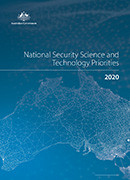National Security Science and Technology Centre

Given the commitment and capacity of adversaries to engineer smarter, more agile, and increasingly innovative technologies to threaten our national security, and the growing challenges arising from our natural environment that test the resilience of our society and national systems, Australia needs to remain at the forefront of science and technology in order to remain agile and anticipative of new and emerging threats.
Currently, Defence, specifically the Defence Science and Technology Group (DSTG), has the responsibility to coordinate national security science and technology. DSTG is recognised as having expertise across key areas of science and technology delivery, experience in establishing and managing diverse research programs, and strong connections with domestic and international science and technology providers.
The responsibilities of the National Security Science and Technology Centre (NSSTC) within DSTG are to:
- Coordinate whole of government national security science and technology, to prioritise requirements, provide governance, reduce duplication, deliver science and technology assurance and improve impact;
- Assure delivery of science and technology value by fostering academic and industry science and technology partnerships to build national science and technology capability and enhance targeted delivery to Australian national security agencies;
- Lead international research collaboration to leverage state of the art capabilities for Australia and to provide regional science diplomacy; and
- Manage DSTG's national security science and technology program, maximising dual-use application of DSTG sovereign capabilities.
Whole of government coordination
The NSSTC engages at the state and federal level through the following mechanisms:
- A National Security Science and Technology inter-departmental committee (NSST IDC) at the Band Three level, co-chaired by the Chief Defence Scientist and Deputy Director General Office of National Intelligence (ONI), provides federal level engagement, steers the national security science and technology program and provides governance.
- The Australian New Zealand Counter Terrorism Committee and its sub-groups provide engagement with the jurisdictions.
- The previous cross-agency Band One Round Table meeting has been repurposed to actively shape the national security science and technology requirements against the agreed priorities.
- A Publicly Funded Research Agency (PFRA) Round Table has recently been established which seeks to collaboratively utilise the broad and accomplished science and technology knowledge held within the PFRA community.
- NSSTC has embedded Science Counsellors within other Government departments. These senior appointments assist to coordinate capability and science and technology across Home Affairs and National Intelligence Community agencies.
The National Security Science and Technology Policy and Priorities, as foreshadowed in the 2016 Defence Industry Policy Statement, were agreed by the NSST IDC in November 2017 and were released by the then Minister for Defence Industry, Minister Pyne, in May 2018.
In 2020 the National Security Science and Technology Priorities were updated with broad input, close engagement and agreement across the national security community and released on October 13, 2020 by the then Minister for Defence, Senator the Hon Linda Reynolds CSC. This is a thorough update to the 2018 Policy and Priorities, with greater consideration given to recent challenges such as national resilience and biosecurity. The updated Priorities can be found here.
Priority areas
The six national security science and technology priority areas are:
Technology Foresight
The ability to monitor, analyse and evaluate the implications of scientific and technological developments to prevent strategic and tactical surprise.
Intelligence
The ability to collect, analyse, integrate, assess and disseminate intelligence with the accuracy, scale and speed required to support timely national security and intelligence decision making.
Preparedness, Protection, Prevention and Incident Response
The ability to appropriately equip and prepare Australian agencies to effectively address national security threats and natural or man-made destructive events, including mass-harm and mass-damage incidents, either by preventing their occurrence, or responding and recovering effectively if they have occurred.
Cyber Security
The ability to strengthen the cyber security and resilience of critical infrastructure and systems of national significance through the conduct of research and development, and the delivery of advanced cyber technologies, tools, techniques and education.
Border Security and Identity Management
National security community’s ability to protect and secure Australia’s borders from disease outbreaks, hazardous material and threats to our community, including maximum disruption effect on illegal activity and migration with projected growth in people and cargo movement across Australian borders.
Investigative Support and Forensic Science
Law enforcement’s ability to prevent, disrupt and prosecute terrorist and criminal activities in a complex transnational and evolving digital environment.
Fostering academic and industry partnerships
The NSSTC continues to strengthen national science and technology partner capabilities to enhance targeted delivery to the Australian national security agencies. NSSTC participated in the May 2018 Civil Security Congress and Exposition which provided an opportunity to widely engage with Australian industry.
Of particular note, two Australian companies have produced equipment in the areas of explosive trace detection and stand-off detection of improvised explosive devices following receipt of NSSTC development funding.
Some current projects include:
- Novel fingerprint detection techniques
- Developing CBRN risk protocols to ensure first responder safety
NSSTC has also partnered with the Office of National Intelligence on a National Intelligence and Security Discovery Research Grant Program which focuses on early-stage research to address National Security and Intelligence challenges aligned with the National Security Science and Technology Priorities. The Program was announced departmentally on 13 October 2020 following the Prime Minister’s endorsement and is co-funded by DSTG and ONI to the value of $18m over three years.
The National Security College Futures Hub at the Australian National University hosted, in partnership with DSTG, a Technology Surprise Forum in early May 2022. The Forum highlighted a range of high impact future technologies that could influence the Australian national security landscape over the next 5 to 10 years. Detailed reports will be delivered to agencies shortly. Further background information can be found here.
Please note that proposals to address specific national security requirements will be advertised through targeted mechanisms. The National Security Science and Technology Centre is only resourced to consider proposals addressing advertised requirements.
Fostering international collaboration
The NSSTC maintains bilateral Memorandums of Understanding with the following international partners:
| US Department of Homeland Security | |
| Irregular Warfare Technical Support Directorate | |
| UK Home Office | |
| Canadian Centre for Security Science | |
| New Zealand Ministry of Business, Innovation and Employment |
Building on the successful bilateral engagements between allied nations, a Five Nation Research and Development Initiative (5RD Initiative) has been established which seeks to create new opportunities to deliver more efficient and cost-effective access to results, expand research, development, testing, and evaluation capacity, and offset limitations in a constrained and fluctuating budget environment. The objectives of the 5RD Initiative are to:
- DISCOVER collective knowledge of emerging threats and risks;
- CONNECT with each other to coordinate RDT&E planning and prioritisation for efficiency and cost-effectiveness; and
- LEVERAGE each other capability to avoid efforts and duplication.
Some examples of recent international projects include:
- Five Eyes Forensic and Technical Exploitation Handbook
- Technology Foresighting.
DSTG’s national security science and technology program
The NSSTC drives dual-use application of sovereign DSTG technology encouraging applicability in both military and national security environments.
DSTG has directly contributed to the nation’s security through the delivery of national security science and technology solutions in areas such as facial recognition algorithms, video analytics, vehicle survivability, decision support systems, blast modelling, cyber open-source training, home-made explosive characterisation and threat assessments, toxic chemical detectors and support to numerous operations.
Specific work includes assistance with the characterisation of the threat for the aviation security incident in Sydney July 2017 and recently working with Home Affairs to host a Chemical, Biological and Radiological Capability Exercise (CAPEX) in Queensland, which involved CBR specialists from Australia, Canada, United Kingdom and the United States.


